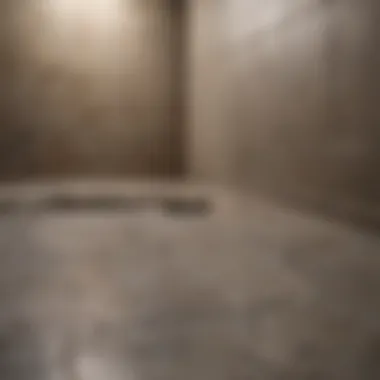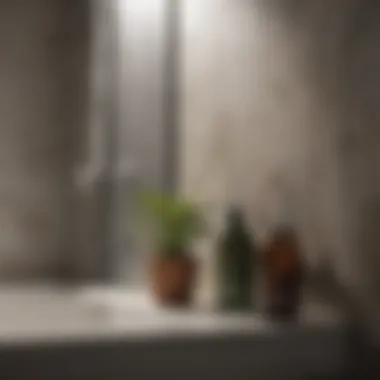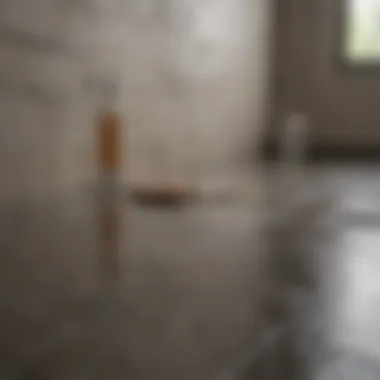Effective Strategies for Removing Mold from Shower Grout


Intro
Mold in shower grout is more than just an eyesore. It can indicate moisture issues and may pose health risks to individuals in the household. Understanding how to effectively remove and prevent mold growth in this area is essential for maintaining a clean and safe bathroom environment. This article aims to present a detailed analysis of various methods for combating mold in shower grout, focusing on both chemical and natural solutions.
Homeowners and renters alike will benefit from learning about the effectiveness and safety of each method, as well as the importance of regular maintenance. Our guide explores practical strategies that ensure not only short-term success but also long-term mold resistance. A focus on prevention can save time and effort in the future, while a consistent cleaning regimen will keep the bathroom looking fresh.
With a strong emphasis on best practices, this article is structured to support your efforts in managing mold effectively. Whether you are dealing with an existing problem or looking to safeguard your space against future growth, you will find valuable insights ready at your disposal.
Understanding Mold in Shower Grout
Understanding mold in shower grout is essential for maintaining a healthy bathroom environment. Mold is not just an aesthetic problem; it can lead to various health issues if not properly addressed. Shower grout, often damp and porous, provides an ideal environment for mold proliferation. Recognizing the importance of understanding this subject helps homeowners take proactive measures to combat mold growth.
What is Mold and How it Develops
Mold is a type of fungus that thrives in moist environments. In bathrooms, mold grows on surfaces where humidity is high, such as the grout lines of tiles. Mold spores are everywhere in our environment and can easily settle on damp surfaces. When conditions are right, these spores can germinate and develop into mold colonies. The process usually begins when spores absorb moisture. From here, they can grow rapidly, leading to visible patches of mold.
To effectively manage mold, it's vital to comprehend its life cycle. Mold constantly reproduces by releasing spores into the air. This makes controlling it more challenging. Once it takes hold, mold can produce allergens, irritants, and potentially toxic substances called mycotoxins. Understanding this process will help in choosing the right removal strategies and preventive measures.
Factors Contributing to Mold Growth in Bathrooms
Several factors contribute to mold growth in bathrooms, especially in shower areas. Here are some key contributors:
- Humidity Levels: High humidity makes bathrooms a breeding ground for mold. Keeping humidity levels above 60% often encourages growth.
- Poor Ventilation: Bathrooms that lack proper airflow trap moisture. Bathrooms without windows or exhaust fans are particularly vulnerable.
- Temperature: Warm environments support mold growth. The typical bathroom temperature combined with humidity creates ideal conditions.
- Dampness: Leaks or spills that are not cleaned up can provide mold with the moisture needed to thrive.
- Material Used: Porous materials, like grout, can absorb moisture and harbor mold. In contrast, non-porous surfaces like glass or plastic resist mold growth better.
Understanding these factors is crucial for effective mold prevention. Regular maintenance and monitoring conditions can reduce the likelihood of mold emergence. Homeowners should stay diligent about keeping their bathrooms dry and well-ventilated to combat this issue.
Identifying Mold Types Commonly Found in Bathrooms
Understanding the different types of mold that can appear in bathrooms is crucial for effective remediation. Various mold species have distinct characteristics and potential health risks associated with them. By identifying the type of mold present, homeowners can select the most appropriate removal method and prevent future growth. Each mold type requires different strategies for both eradication and prevention.
Black Mold: Health Risks and Removal
Black mold, scientifically known as Stachybotrys chartarum, is a common but dangerous type of mold found in damp areas. It is characterized by its dark green or black appearance. Exposure to black mold can lead to a multitude of health issues. Symptoms may include respiratory problems, skin irritation, and even neurological issues in severe cases. This is why it is necessary to address it promptly and effectively.
To remove black mold from shower grout, a thorough approach should be taken. The following steps will aid in its removal:
- Safety First: Wear protective gear, including gloves and a mask, to avoid inhaling spores.
- Preparation: Ventilate the area by opening windows or using fans to help circulate air.
- Cleaning Solution: Use a mixture of water and bleach, ensuring a ratio where bleach is no more than one part to ten parts water. Apply this solution to the affected areas.
- Scrubbing: Use a stiff brush to scrub away the mold, ensuring you reach into the grout lines.
- Rinse and Dry: Rinse the area thoroughly with clean water and ensure it is dried completely to prevent future growth.
"Identifying black mold is not just important for aesthetic reasons; it significantly impacts the health and well-being of those in the home."
Green and White Mold: Characteristics and Solutions
Green and white mold are less harmful than black mold, but they still can pose health risks, particularly for individuals with allergies or respiratory conditions. Green mold commonly signifies Aspergillus, while white mold often refers to Penicillium.
Each type can develop in bathroom environments with high humidity. Here are some ways to deal with these mold types:
- Identifying Green and White Mold: Green mold usually appears fuzzy or powdery, while white mold may look smooth and cotton-like.
- Cleaning Solutions: A solution of water mixed with vinegar can be effective for both green and white mold. This is because vinegar has natural antifungal properties.
- Application: Apply the mixture directly to the moldy areas and let it sit for about an hour.
- Scrubbing: Use a non-abrasive scrub brush to remove mold from the grout and tiles.
- Rinse Thoroughly: As with black mold, rinse away any remaining cleaning solution and dry the area completely.
By understanding the characteristics and risks associated with each type of mold, homeowners can better ensure their living spaces remain healthy and mold-free.
Chemical Solutions for Mold Removal


In the ongoing battle against mold in shower grout, chemical solutions serve as an important line of defense. They possess unique properties that can effectively target and eradicate mold spores. Their effectiveness often translates to quick results, making them attractive options for homeowners dealing with an infestation. However, there are a few considerations to keep in mind.
Many chemical solutions contain strong ingredients that can pose health risks if misused. Therefore, safety precautions are essential during the application process. Additionally, some solutions may alter the appearance of grout if not properly diluted or applied. Understanding specifics about the active ingredients and their proper use is vital for optimal results. This section explores these key chemical solutions in detail, enabling readers to make informed choices for mold removal in their bathrooms.
Bleach: Effectiveness and Application
Bleach is one of the most widely recognized mold removers. Its active component, sodium hypochlorite, breaks down the mold structure, ensuring it can no longer survive. Bleach is notably effective against most types of mold, especially on non-porous surfaces like tile and certain grout types.
When applying bleach, proper dilution is critical. A common recommendation is mixing one cup of bleach with a gallon of water. This solution can be applied using a spray bottle or a sponge. Safety measures should always be adhered to: use rubber gloves and ensure the area is well-ventilated. It is also wise to keep bleach away from any colored surfaces, as it may cause discoloration.
- Preparation: Ensure the area is free from debris, then wear protective gloves and goggles.
- Application Method: Spray or sponge the bleach solution onto the grout. Allow it to sit for about 10-15 minutes.
- Final Step: Rinse thoroughly with water to remove any residue.
While bleach is effective, it does not prevent mold from returning. Therefore, ongoing maintenance is required to minimize reoccurrence.
Hydrogen Peroxide: A Safer Alternative
Hydrogen peroxide is emerging as a popular alternative to bleach. With a concentration of 3% being widely available, it effectively kills most mold strains without the harsh chemicals found in bleach. Because of its effectiveness and lower toxicity, it is especially suitable for households with children or pets.
When using hydrogen peroxide, it is advisable to apply it directly to the moldy area in its concentrated form. Allow it to sit for about 10 minutes, then scrub the area with a brush to lift the mold from the grout. Rinse with water after scrubbing to ensure all residue is cleared. It’s important to note that hydrogen peroxide may have a bleaching effect on some rubber or colored grout.
Using Commercial Mold Removers
Commercial mold removers provide convenience and often incorporate multiple active ingredients designed to combat mildew and mold. These products are designed for usability, often labeled clearly with instructions for application and safety precautions.
Many commercial options contain antifungal agents and cleaning ingredients that break down mold spores effectively. A few popular brands include Tilex and Mold Armor. These products often come in spray bottles for ease of use.
- Read Instructions: Each product has specific guidelines. Ensure understanding before use.
- Application: Spray generously on affected areas and let it sit as recommended on the label.
- Scrubbing: After waiting, use a brush to scrub the mold away.
- Rinse: Thoroughly rinse the treated grout with water to ensure all chemicals are flushed away.
Natural Remedies for Mold Prevention and Removal
Mold in bathrooms is a common nuisance. It thrives in damp environments, making the shower grout particularly susceptible. While chemical solutions are an option, natural remedies offer a more eco-friendly approach. These remedies not only effectively combat mold but also help in preventing its return. Here, we explore different natural solutions, their benefits, and considerations that homeowners should keep in mind.
Vinegar: An Effective Anti-Fungal Agent
Vinegar is a household staple known for its versatility. This acetic acid solution has powerful anti-fungal properties, making it effective against mold. When using vinegar for mold removal, options are simple:
- Spray undiluted vinegar directly onto the affected areas.
- Allow it to sit for at least an hour.
- Scrub with a brush or sponge to remove any remaining residue.
Vinegar is effective because it alters the pH level of the surface. This change makes it hostile for mold spores. Unlike some commercial cleaners, vinegar is non-toxic and a safer choice for families with small children or pets. However, its strong odor can linger for a while, so adequate ventilation is necessary.
Baking Soda: Absorption and Scrubbing Properties
Baking soda is another common kitchen item that serves as a potent mold-fighting agent. It has two primary properties that help in mold removal:
- Absorption: It can absorb moisture, a key factor in mold growth.
- Scrubbing: It provides gentle abrasiveness for thorough cleaning without damaging surfaces.
To use baking soda against mold:
- Mix one tablespoon of baking soda with water to form a paste.
- Apply the paste on the moldy grout.
- Scrub with a brush.
- Rinse with water and spray a little vinegar afterward for maximum effect.
This combination not only helps in breaking down the mold but also neutralizes odors. Baking soda is safe and is often readily available in most kitchens.
Tea Tree Oil: Expanding Your Mold-Fighting Arsenal


Tea tree oil is well-regarded for its antimicrobial properties. Despite being more expensive than other remedies, its effectiveness justifies the cost. It can inhibit the growth of mold and mildew, making it valuable for long-term prevention.
To utilize tea tree oil:
- Mix one teaspoon of tea tree oil with one cup of water in a spray bottle.
- Shake well to ensure the oil is evenly distributed.
- Spray the solution on the mold-affected areas and do not rinse it away.
The scent of tea tree oil also adds a refreshing aroma to the bathroom. While it is generally safe, it is crucial to ensure good ventilation when applying tea tree oil, as the concentrated oil can be overpowering.
"Natural remedies not only remove mold but also help create a healthier home environment when applied consistently."
In summary, natural remedies are effective for mold prevention and removal, offering safer alternatives to harsh chemicals. Homeowners should consider incorporating these solutions into their cleaning routine. By doing so, they can maintain cleaner, healthier bathrooms while safeguarding their home against future mold growth.
Step-by-Step Guide to Removing Mold from Shower Grout
Removing mold from shower grout is crucial for maintaining a clean and hygienic bathroom environment. Mold not only presents an aesthetic problem but can also lead to health issues if not addressed promptly. An effective method involves systematic preparation, application of solutions, and thorough cleaning. Each element of this guide serves to help homeowners achieve lasting results.
Preparation: Tools and Safety Measures
Before diving into mold removal, it is essential to gather the right tools and ensure safety. Here are the key items you will need for this task:
- Protective Gear: Use gloves and a mask to protect your skin and respiratory system from mold spores and cleaning chemicals.
- Scrub Brush: Opt for a stiff-bristled brush to effectively scrub the grout lines.
- Spray Bottles: These are necessary for applying your cleaning solutions evenly.
- Baking Soda and Vinegar: Common household items can be your first line of defense.
Safety should not be overlooked. Ensure the area is well-ventilated while working to minimize inhalation of fumes. If using stronger chemical solutions, consider ventilating for a longer period and don’t forget to dispose of cleaning materials responsibly.
Application Methods for Different Solutions
Once equipped, it’s time to apply the solutions. Here is how you can approach common cleaning methods:
- Vinegar and Baking Soda: Mix equal parts vinegar and water in a spray bottle, then spray it on the affected areas. After about 10 minutes, sprinkle baking soda over the wet grout. This combination will create a fizzing reaction that helps lift mold.
- Bleach Solution: For more stubborn mold, a bleach solution may be necessary. Mix one cup of bleach with a gallon of water in a bucket. Apply the solution with a scrub brush to the grout. Let it sit for 10-15 minutes before rinsing thoroughly. Remember, bleach can discolor surfaces, so test a small area first.
- Commercial Mold Removers: Follow the directions on the product label. These solutions are typically very effective and often formulated specifically for mold removal.
Whichever method you choose, use a scrub brush to work the solution into the grout. This step is crucial for ensuring the mold is fully penetrated and lifted.
Final Touches: Cleaning and Disinfecting
After applying your chosen solution, it's important to complete the cleaning process properly.
- Rinse Thoroughly: Make sure to rinse the area with clean water to remove all cleaning residues. This may require several passes with a wet cloth or sponge, especially if bleach was used.
- Dry Completely: Use a clean towel to dry the grout, as dampness can encourage new mold growth.
- Disinfect Regularly: To help prevent mold from returning, incorporate regular disinfecting into your cleaning routine. Consider using a solution of vinegar and water to wipe down the shower after each use.
"Preventative measures are as important as removal. Regular maintenance keeps mold at bay."
These steps provide a systematic approach to removing mold effectively and can educate homeowners about the importance of maintenance in mold prevention.
Tips for Preventing Future Mold Growth
Mold can pose serious health risks and damage to your home. This makes prevention crucial. Implementing effective strategies for preventing future mold growth can save time, money, and health issues. The key components include optimizing ventilation, maintaining a cleaning routine, and applying protective treatments to grout.
Maintaining Optimal Ventilation in the Bathroom
Ventilation plays a crucial role in controlling moisture levels in bathrooms. Adequate airflow helps to keep humidity levels down, which minimizes the likelihood of mold growth. Ways to improve ventilation include:
- Using exhaust fans during and after showers.
- Cracking a window to promote air circulation.
- Keeping doors open to allow airflow.


By ensuring that your bathroom is well-ventilated, you can significantly reduce the rate at which mold spores settle and grow. This may also help keep your space smelling fresh.
The Role of Consistent Cleaning Practices
Regular cleaning is essential in preventing mold. It helps remove moisture and mold spores before they can develop into larger problems. Establishing a cleaning schedule can keep surfaces in your bathroom clean. Consider:
- Wiping down shower walls and fixtures after each use.
- Using mold-resistant cleaning solutions, especially for grout and caulk.
- Regularly washing shower curtains and bath mats.
Consistency ensures that mold cannot take hold. Focus on problem areas, such as around faucets and in corners, where moisture tends to accumulate.
Sealants and Grout Treatments
Periodic maintenance of grout involves treating it with sealants. This adds a protective barrier that can prevent moisture penetration. Select a high-quality grout sealer and apply it as recommended. This can prolong the life of your grout and minimize the risk of mold growth. Key points to consider include:
- Choose a grout sealer suited for wet environments.
- Reapply sealants every couple of years, or sooner if you notice staining or reduced effectiveness.
Applying sealant is straightforward but requires attention to detail. It helps maintain the appearance of your bathroom while resisting mold growth.
In summary, preventing future mold growth requires a focused approach that combines ventilation, cleaning, and protective sealing. Implementing these strategies can lead to a healthier bathroom environment.
When to Seek Professional Help
Mold removal is not merely a matter of aesthetic concern; it can impact health and safety. Therefore, understanding when to consult professionals for mold remediation is crucial. Several factors come into play, including the severity of the infestation, the types of mold present, and the potential impact on your living environment. Recognizing these factors can save time, effort, and even health.
Recognizing Persistent Mold Infestations
Persistent mold growth in shower grout often signals a deeper underlying issue. Homeowners should assess the situation if they notice any of the following:
- Reoccurring Mold: If mold returns shortly after cleaning, this indicates that the source of moisture isn't addressed.
- Large Areas of Coverage: Mold covering an area larger than ten square feet typically needs professional attention. Small patches may be manageable for homeowners, but expansive growth suggests systemic problems.
- Hidden Mold: Mold can exist within walls or behind tiles, which is often out of sight yet damaging. A musty odor in the bathroom may hint at hidden infestations.
- Health Symptoms: Increased allergy symptoms or respiratory problems within the household may correlate with mold presence.
Recognizing these signs may trigger the need for expert evaluation. Professional services can identify and rectify moisture sources, often overlooked by casual cleaning.
The Benefits of Professional Mold Remediation
Engaging professionals for mold remediation offers several advantages that can outweigh the DIY approach:
- Expert Assessment: Professionals have the training to accurately assess the mold type and extent, which is crucial for effective removal.
- Advanced Techniques and Tools: Experts employ specialized equipment and methods that are not available to the average homeowner. Techniques like HEPA vacuuming and encapsulation ensure thorough cleaning.
- Thorough Mold Removal: Professionals can reach hidden mold sources and fully eradicate spores, significantly reducing the chances of regrowth.
- Preventing Future Issues: They can provide recommendations on moisture control and other preventive measures to reduce future risks of mold growth.
"Mold remediation is as much about addressing visible issues as it is about understanding the environment that allows it to thrive."
- Health Protection: Proper handling of mold ensures that allergens and toxins are contained, thus protecting the health of everyone in the home.
Ultimately, while DIY removal might be feasible for minor instances, professional assistance is often a kinder, thorough approach in critical situations. For homeowners facing persistent issues, seeking expert help is a sound decision.
Closure
In summary, addressing mold in shower grout is critical for maintaining a healthy bathroom environment. This article explored various effective strategies that empower homeowners to combat mold. The strategies include chemical solutions like bleach and hydrogen peroxide, as well as natural remedies such as vinegar and baking soda. By understanding and applying these approaches, individuals can successfully remove mold and prevent future infestations.
Recap of Effective Strategies for Mold Removal
To effectively remove mold from shower grout, it is important to follow several key steps. First, preparation is crucial. Gather your cleaning tools, which may include brushes, gloves, and chosen cleaning solutions. Then, apply the cleaning solution according to its instructions. Scrubbing the grout gently yet thoroughly helps remove the mold. Finally, rinse the area well and disinfect to ensure any remaining spores are eliminated. Regular cleaning and maintenance make a big difference.
- Identify your approach: chemical or natural solutions?
- Prepare your tools and area before starting.
- Apply your selected solution carefully and scrub.
- Ensure to disinfect for complete mold elimination.
The Importance of Vigilance in Mold Prevention
Preventing mold growth requires ongoing vigilance. Mold does not disappear on its own. Regular maintenance and monitoring of humidity levels are essential. Keeping the bathroom well-ventilated allows moisture to escape, reducing the chance of mold proliferation. Additionally, using sealants on grout can protect it from water damage. Remember that mold can grow quickly, so consistent cleaning habits are beneficial.
"Regular check-ups and preventive measures can save you from larger problems down the road."



